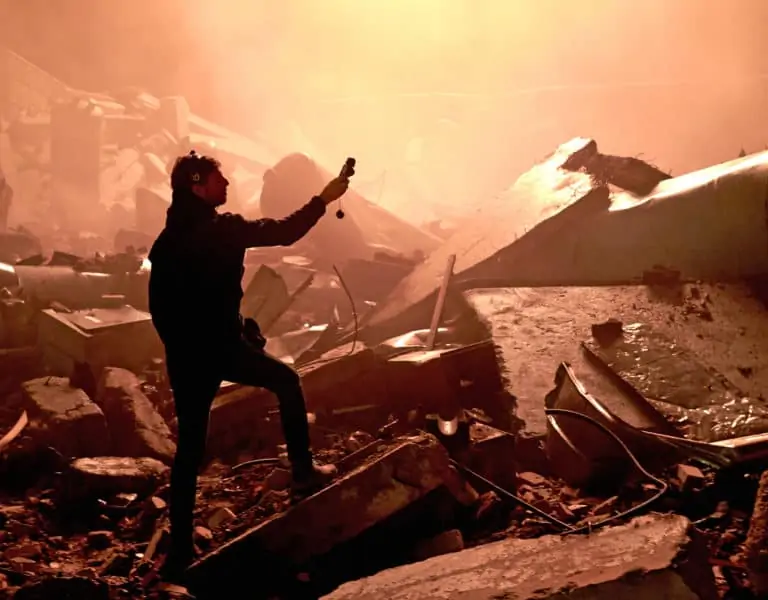History makers
Lensing a satire-laced mockumentary set in 17th-century Poland was a unique challenge for cinematographer Nils Croné FSF.
Take a rip-roaring ride through 17th-century Poland in Netflix’s 1670, which follows crazy nobleman Jan Paweł Adamczewski as he vies to become Poland’s most famous and important person. You don’t need to know much about Polish history to get swept away by this fast-paced and funny mockumentary.
Nils Croné FSF takes us through his work on the show, collaborating with directors Maciej Buchwald and Kordian Kadziela.

How did you get involved with 1670?
When I moved back to Poland after a few years in Sweden, I started out by acting as DP on the second season of the Netflix show Sexify. As we were reaching the end of production in early 2022, the producer of the show, Jan Kwieciński, reached out to me to see if I would be interested in reading a pitch for a new historical mockumentary show that they were currently developing.
What appealed to you about shooting this fun historical comedy?
First of all, I found the screenplay by Jakub Rużyłło captivating and found many things to love in its characters. Initially I slightly bounced off the mockumentary aspect of the show. I wasn’t sure how to approach the show, especially having come off a few very visually colourful projects. This would be more natural – and initially was pitched as having a way different camera language than what we ended up with. More grounded in documentary filmmaking, in the style of The Office or What We Do in the Shadows. It turned out though that our initial common hesitancy to the format, and unwillingness to simply repeat an already established form, was crucial in director Maciej Buchwald and I finding a common ground.
In the end, I’m certain my initial hesitancy came from a place of being challenged to do something that was new for me. I had never shot a historical project before – and even more questions arose when we had to somehow fit an observational camera naturally in there. How do you motivate a film crew 400 years ago?In the end, I very much believe in going after projects that make me initially frightened and that I have no idea of how to accomplish. I loved the script and the characters, and because of that I felt obligated to join the journey of 1670.
I understand you studied in Poland and are now based there, so you must speak the language pretty well – did you manage ok on the shoot? How much of your work is split between Poland and elsewhere?
I moved to Poland back in 2013 to study at Łódź Film School. When you get admitted as a foreigner to the school, you have to do one year of preparatory language studies – as the whole education is exclusively in Polish. So, before I could actually start my cinematography studies at the school, I spent a year deep in the Polish language, getting to know people from the school, sporadically helping out on student film sets and getting to know the Polish culture. Of course, after a year you only speak so well – I believe it took me another year and a half, of after having started my actual film studies, when I woke up one day and suddenly felt a big weight had lifted off my chest. Mostly I think it was related to stopping being embarrassed for my lack of grammar knowledge, and simply starting to chat.
After my school finished back in 2019, I moved back to Sweden for a few years, before eventually moving back in 2021 – since then I’ve more or less been able to work exclusively in Poland and in Polish. As with any film sets, some of the “on-set lingo” is universal – but my main communication with my camera and lighting crew is in Polish for sure. Then it usually depends on the director on which language we communicate with.
In the end it usually ends up with our own style of “Polglish”. The above being said, in 1670 initially I did somewhat struggle with a few words and phrases, mostly in the screenplays – I hadn’t previously been confronted with some of the terminology of 17th-century Poland. So my vocabulary has definitely increased over the last two years!
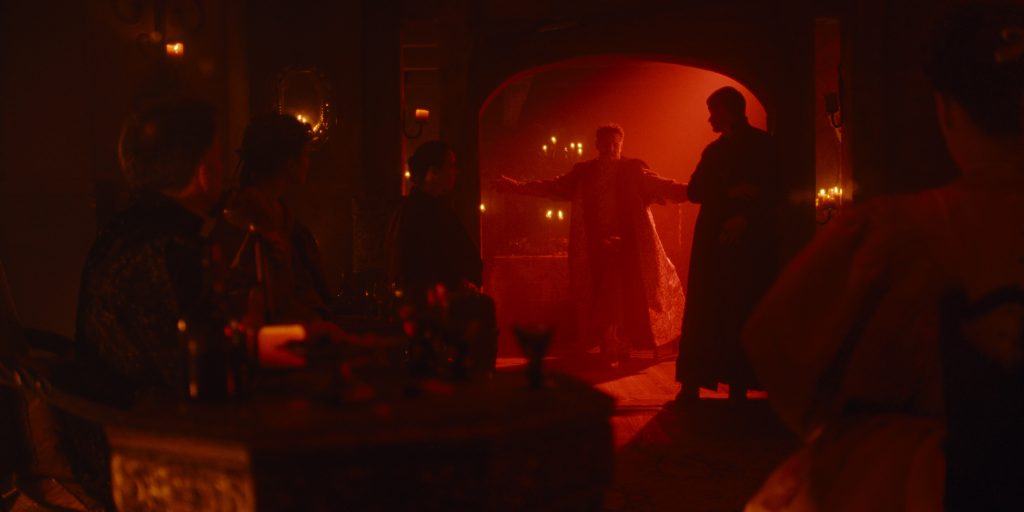
You worked with two different directors on the series – Maciej Buchwald and Kordian Kadziela. How did their approaches differ and how did you adapt to them?
There were some differences, of course, but a big help was the fact that we all spent a lot of time together even before we started to practically work on things like visual breakdowns, shotlists, moodboards etc. I believe Maciej and Kordian have a very similar sense of humour which definitely helped in our discussions about the story and its characters.
Beyond that, the most important thing for all of us was to be honest to the characters and the story. We all had to be on the same page in the way the story progressed and how we would approach the visual storytelling.
Maciej and Kordian’s episodes are by nature also slightly different and did require different approaches – Maciej has the burden of the initial four episodes, so we were also tasked in his episodes to introduce the viewer to our world and to our way of storytelling. I’d say from the third episode – titled “Spring” – and onwards, once all the characters and basic plot lines have been presented, we gave ourselves permission to play around with the format much more. Our visual language in that episodes moves quite drastically from being observational to being much more subjective – we could suddenly be inside our characters’ dreams and desires and move away from naturalism, landing in a more subjective approach.
With Kordian’s episodes, the subjectivity continued. We could allow ourselves to be much freer with our format and start integrating new genres into the styles – see a particular exorcism scene in episode seven for some examples of horror movie tropes. When we reached the ultimate episode of the season, it had moved away quite a bit from the initial visual language, as we glide and fly through a wedding party on long unbroken shots. Still though, I’d like to emphasise that the actual process of work was quite similar with both Maciej and Kordian – we spent a lot of time breaking down every scene, finding inspirations in all kinds of places – combining and dividing scenes and really going through every visual aspect of each episode – something that took quite a few months of work.

What was the vision for the look and mood of 1670?
Whilst the show stared our originally envisioned as being of more of a classic “mockumentary”, i.e. a reactive handheld camera with spontaneous zooms and our characters being aware of the film crew being there, this evolved and changed during my first discussions with director Maciej Buchwald. We were both struggling with seeing the film as a pure “pretend” documentary. How do we avoid a situation where people don’t see past the fact of “hey, there were no cameras 400 years ago”?
We struggled with it for quite some time – especially when it came to the interview parts of the story. Who is interviewing them? Originally it was supposed to be revealed at the end of the story, that we were following a chronicler, that came to the village of Adamczycha in order to tell their story – but then that leads to its own fair share of problems, like “why is this person here watching this moment, and why are people not reacting to her/ his presence?”. We moved through many different instances of these discussions.
It was important for us to be able to be physically close to the characters and to often be at the centre of a scene, and not only be outside observers. We moved through the prep process trying to find a reasoning for this for quite some time – for a while we thought to shoot our characters’ confessionals to camera in a very direct manner: they’d actually be praying – to religious icons, to nature, to the sky. But that was also limiting, and still felt convoluted.
Eventually, we realised that what we were looking for was right in art history all along: paintings. By making our characters sit in places and poses where they could have been posing for portraits to be painted, it also included an aspect of the characters themselves deciding how they’d like to be perceived. Hence, when one of our main characters, Zofia (Katarzyna Herman), talks down about the townsfolk coming to visit their village, she is posing as a learned noblewoman, as that is the position of power that she’d like to project.
In other scenes, the interviews take on a more subjective approach, such as in the end of episode eight, where our main character Jan Paweł (Bartłomiej Topa) is pictured talking to us on a bed of flowers – of course in part inspired by (or well, stolen from) American Beauty. Our character has reached the pinnacle of his goals and is almost similar to a king after a field of battle. We as the audience at this point can see the irony in this, but the images had to be loyal and honest to how our characters feel and how they want to be portrayed.
Beyond this, another part of our style, that comes from a mockumentary background, would be the glances to camera. We wanted to move away from the glances coming from a source of our characters being uncomfortable with that they are being watched. That would have again characterised the camera as a physical presence within the scenes. Rather we wanted the characters themselves to choose where and when they break the fourth wall – to comment something to the viewers, or look for support.
Overall, as we discussed the visual aspect the language of the camera moved away from being an observant one, to being one that actively takes part in the scenes. In that sense, we set out to mostly follow a visual language akin to classic epic historical films, but in which, the characters can talk to us, rather than it being of a pure mockumentary format.

Take us back to prep. How long did you have? What research did you do?
My first meeting with Maciej Buchwald, was back in April of 2022. Following that we met quite regularly, once every two weeks – chatting about the format itself and getting on the same wavelength – up until we got officially greenlit the same summer. From around August we met more and more often, and went on the first couple of location scouts, and from September I was prepping full time. From then on it was all hands on deck to hit our start date of production, in early January of 2023.
Most of my research was honestly done during my discussions with Maciej and Kordian. We watched a lot of films, one of the most interesting examples of this is probably local politician’s campaign videos – often done in good intention but sometimes with slightly questionable taste. As mentioned previously, sometimes we wanted our characters to have planned their own shots, perhaps Jan Paweł would have thought “it will look really good if my peasants drive me in on a wagon in this shot”, as in an improvised dolly. In reality of course, it just goes to further underline the difference between nobles and serfs in 17th-century Poland.
Then again, we didn’t want to laugh at our characters. It was important for us that we also learn to love all of them, faults and all. For our main character, he doesn’t necessarily see it as something absurd and wrong, that he is using his peasants to help him do his bidding. That’s simply how the world works, in his mindset.
Beyond that, I did of course look into Sienkiewicz’s Trilogy With Fire and Sword, The Deluge and Fire in the Steppe as well as Mickiewicz’s Pan Tadeusz for historical context. While of course I have seen, and did somewhat return to both Jerzy Hoffman’s and Andrzej Wajda’s film adaptations of those works – it was a key component of film history studies back in Łódź – I tried to not return specifically to them very deeply in preparation for 1670. Both the books as well as the films are landmarks of Polish culture, and I was wary of repetition and/or imitation to a too large degree when it came to the historical context.
I believe in finding inspiration a little bit from everywhere – audiences nowadays are so literate in film language, that I think they are also excited about us playing with genre and mixing it up. Beyond working on the overall style of the show, we gave ourselves liberty to look to the world of comic books, music videos and films from completely different genres and time periods, in order to inspire certain scenes. Over the period of the film we worked through an eclectic collection of inspirations from The Exorcist, music videos from The Blaze and Prince, Austin Powers, Tarkovsky’s Ivan’s Childhood, Sin City and Da Vinci’s The Last Supper, just to name a few.
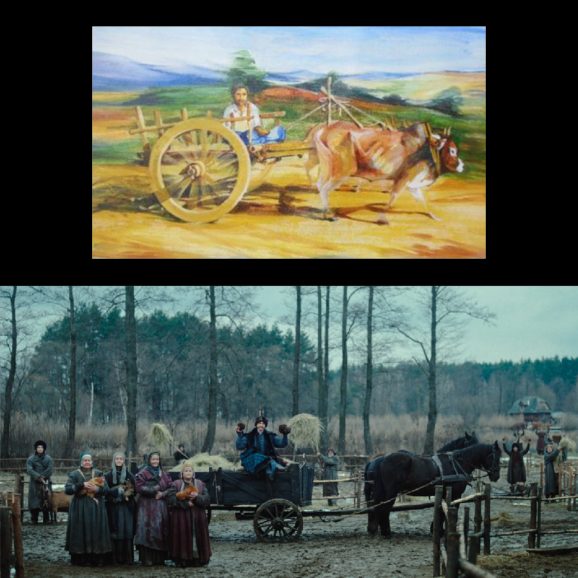

What testing did you do?
Apart from the previously mentioned two-day test shoot, I did a few other bits of testing, starting out by trying most of the available Netflix-approved camera packages. We did do quite a few tests to find the right glass, as well as for look development for our show LUT, as well as post processing on the material.
What camera and lens package did you decide on and why?
As we had such a broad range of genres to work through, I understood quickly that we needed a neutral starting point. That, together with our look that often demanded wide-angle close-ups and a fair amount of zoom work, I landed on shooting it in the Super35 format on spherical glass. Part of the charm with actually shooting on location was the fact that we could work with depth, both showing off our location and amazing production design by Mirosław Koncewicz, but also to subconsciously teach the audience the geography of our village. Mostly we were around a t4 to a t5.6 on all daytime scenes, dropping down to a split between t2 and t2.8 on night-time work.
In the end I landed on the then newly released ARRI Alexa 35, shooting on a mix of Ultra and Master Prime lenses, complemented by Angénieux zooms (the 28-76 and 24-290 mm) as our main lens package. On select days we would add everything from the fantastic 8mmR Ultra Prime, to the Canon 50-1000 mm lens, depending on the needs of scenes.
Logistically it was a bit of a challenge as we were shooting about four hours away from Warsaw, but I’m very grateful to ATM Rental in Warsaw, they were life-savers on many occasions. Special thanks also here to their lens guru Marcin Mikołajczyk for all the advice and help.
On basically all daytime shots I used small increments of Tiffen Black Glimmerglass. On night scenes as well as on cloudy daytime scenes I did augment the above with Tiffen Smoque filters, mostly to taste. Whenever we would have candles or fire in the shot, most of the time we would forego one of the filters, in order to avoid double- or triple reflections.
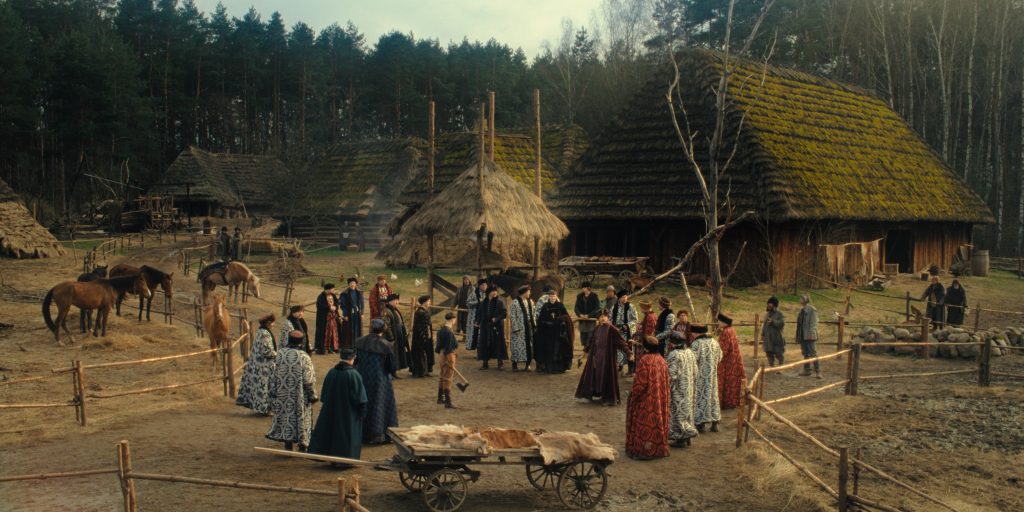
What were the main cinematographic challenges of the shoot and how did you overcome them?
The greatest challenges I had were related to lighting. How do you create contrast when all you have is sunlight, skylight, fire and moonlight? It was a balance that required quite a lot of testing beforehand in order for us to find the right balance to support the story. My gaffer, Hubert Stawicki, and I set out early to find a way to keep a naturalistic look, whilst keeping contrast levels similar throughout the show. Lighting-wise all LEDs were run in X/Y mode (with calculated offsets for warmer/colder tones) in order for us to get as close to the daylight as possible.
Beyond that, to some extent, I feel that the way I perform my work hasn’t changed much in its base definition. The largest difference when budgets increase is in logistics – both in how to work with our 1st AD, the great Aleksander Kowalski, to keep the day moving whilst getting what we need, as well as being able to plan ahead. Together with the directors and Aleksander we spent a lot of time in pre-production working through every scene and shot – what do we need? Whose scene is it, where are we coming from and where are we going? The more we can be prepared in pre-production, the freer we can all be on set, and the more flexible we are to changing things. Those changes can come from things such as unpredictable weather, but also by us being prepared and therefor open for finding even better ways of how scenes can work out once on location.
I especially like the use of camera movement in the show, like the whip pans. Did you operate on the show?
Thank you! I worked with veteran cam op Julo Sus on the whole first season – he operated the vast majority of shots on the show and was a great set of second eyes on set as we set out on this adventure. It meant I could focus on lighting, and working with Maciej and Kordian, with whom for all of us it was our first project together.
I did myself operate on the one-shot dance sequences in episode three and eight – I couldn’t really resist; I started out as a dancer a long time ago, and working with choreographer Weronika Pelczyńska and our actors and dancers was a big challenge due to both the length of the shot and the choreography required in several layers with both our actors and extras. For the dance sequence in episode eight Kordian, Aleksander (who measured the exact size of the barn in which the dance takes place and made sure we stayed within its limits) and I spent four afternoons with the actors and dancers to land on the proper way to both have our actors move in the sequence, while dancing, while delivering dialogue, while giving me with the camera enough space to move. Special thanks during those sequences to key grip Krzysztof Szulim and best boy grip Marcin Brzezek for keeping me from tripping over my own legs. The whip pans are all Julo though!
I was also happy to be joined by Steadicam operators and friends Marek Zajączkowski and Maciej Tomków, who did some incredible work, especially with all the long takes through the wedding party in episode eight.
The whole first season is capped off with a long master shot throughout the entire interior of the main manor house shot by Marek, featuring all of our main characters passing through frame and/or leading our camera – which he nailed in just a couple of takes!
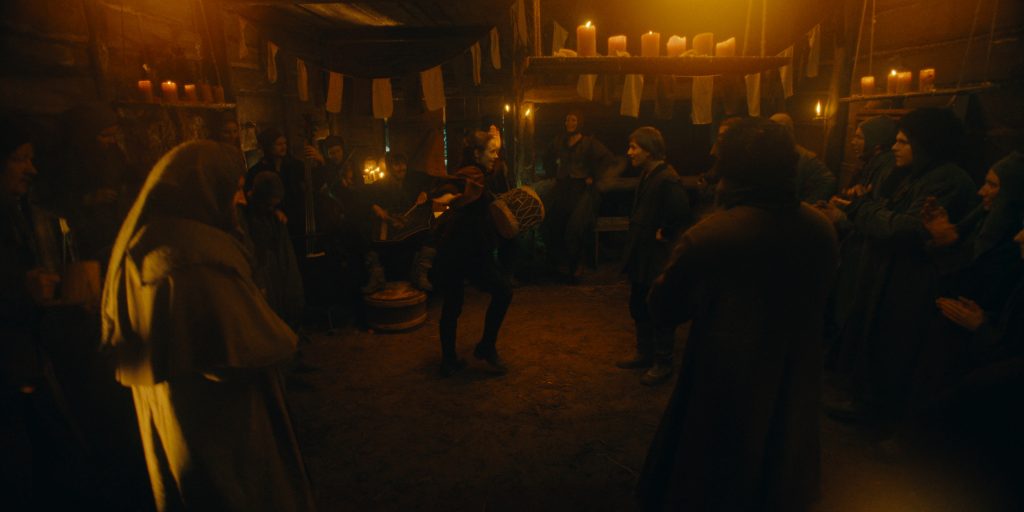
Did you use any new tools or techniques on the shoot?
The biggest change in my own personal way of working, in comparison to how I’ve done things before, was for sure the above-mentioned implementation of X/Y colour measurement in all exterior scenes. The way we were able to work with, and slightly offset, our daylight LED sources quickly whilst taking into account not just the colour of the sky, but the way that daylight bounced off our ground and/or costumes, was a big game changer for me, and something I’m definitely bringing along for future projects.
Tell us about your general approach to lighting. How did you complement your use of candlelight and firelight with more modern sources?
Our general approach to night-time lighting was to mostly augment the lighting that we already had built into our sets. This was made mostly with SkyPanels (60s all the way to the 360s), as well as actual flame bars and gas fires. We also devised a way for us to work with our moonlight in the overall villages. On all-night exteriors we had two large cherry pickers with 4x Nablus Dyno 1200C, with each light facing in different directions in a shape similar to a cube, all skirted off each other. This meant we could remotely dial in the amount of cold moonlight we needed to just fill out the shadows of the village.
For this project we tried to avoid a lot of strong backlit moonlight scenes, and mostly I tried to base the night times around how things would actually look to the naked eye – with some artistic liberties!
What was the hardest scene/location to light?
One of the biggest lighting challenges for sure was the assembly, at the end of episode one. We shot it in St. Paraskevi Church in Radruż, an old, UNESCO-listed wooden church from the 16th century. One of the wall is lined with a fantastic mural covering almost the entire wall featuring paint with golden leaf inside of it. The entire location is very delicate, and hat means no lights on the floor at any time. Together with a rig only involving bounce cards hung from ropes in the ceiling, a few ARRI Orbiters, as well as a large Molebeam gelled to Golden Amber from just far away for the temperature to not be an issue, we managed to light the location to 360 degrees, and the church and especially the mural itself, turned out beautiful in the final episode.
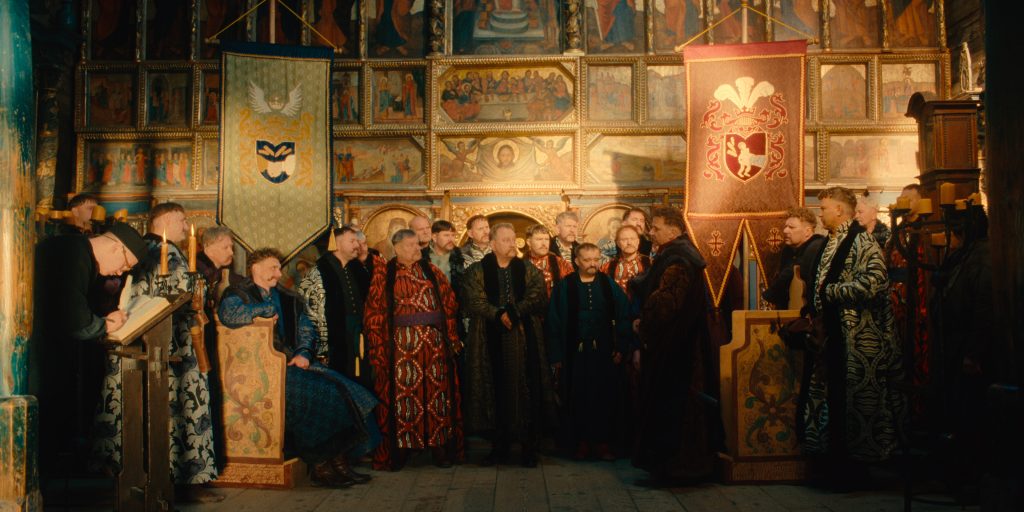
Who did the grade and what look were you aiming to achieve?
The grade of the show was completed by Michał Herman at DiFactory in Warsaw. This is our second project together – after the second season of Sexify – and we have already created a great shorthand. He’s a great artist and has a lot of good ideas that he shares, while being a master of colour science.
For 1670, a big challenge was to both implement a film emulation on the entire show, whilst keeping the whole show consistent and natural looking. It was about taking the edge off the footage slightly, whilst not going too far into a “look”. Part of our challenge was to balance the colour of the beautiful costumes as they moved from location to location. The intricate detail of silver thread in some of the costumes really shine on our Dolby Vision grade, which was our main delivery format for the show.
As far as I am able to, I like to visit as many grading sessions as possible, up to and including the trailers and marketing materials (which were completed before all the episodes were done). Our directors and creative producer, Ivo Krankowski, also joined for a few sessions and gave valuable input, making sure we were all telling the same story.
What part of your work on 1670 are you most proud of?
My favourite moment is most probably the dance scene of episode three. We shot it at the end of our second week of shooting, and the atmosphere that we had in the tavern – which was built from the ground up by our production design team – was incredible.
The whole “dance off” sequence was designed as one long shot in which we whip pan between our two lovers, spin around 360 degrees to see the whole tavern singing along, and finally dollying away from them as they approach each other. It’s meant to show the moment two people fall in love, and I think it goes to show that even in a series which by all accounts is a comedy, we can use the comedy to really tell a serious and heartfelt story. That moment also shows the breadth of the style we created. From going from quite stylised static shots with many cuts, suddenly we are thrust into a 90-second handheld dance sequence. We somehow knew already in planning that we want to break out style in this moment, show that the show it about something more. The fact that we were able to go for this big moment this early in the shooting schedule was scary, but I also think a large source of motivation for everyone in front of and behind the camera. I’m very proud of how it all came together – the night when we shot it is when all the cast and crew became one big family and we realised we’re doing something a bit special, I think.
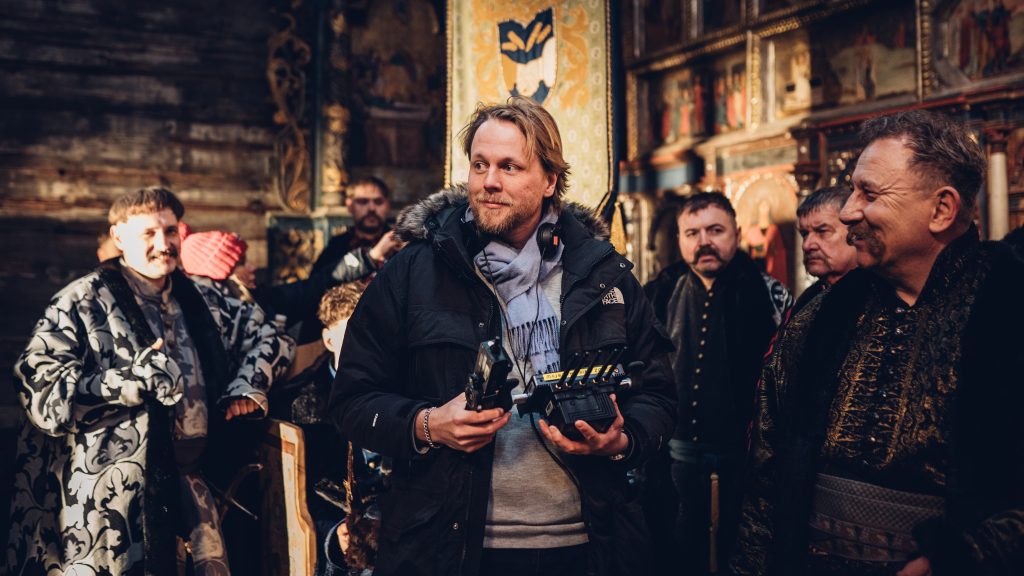
Are there any crew members not yet mentioned whose work you’d like to highlight?
Well, as a cinematographer I feel I’m no better than the people I work with – I’ve been glad to do all my Polish larger projects with my same 1st AC, Ignacy Myśliwiec, who really is a wizard both at focus, and a great team leader for the whole camera department.
Beyond this, it was Michałina Żygarłowska’s first time working with us as a video assist, having been a camera trainee on our previous two projects. She handled it expertly.
Beyond this, Kuba Skrzypczynski, Michał Frączek, our electricians Robert, Dominik, Norbert, Kamil, Sławomir, Grzegorz and Adrian. Beyond this the previously mentioned 1st AD Aleksander Kowalski – this is our third project together and counting, whom is both a great coworker, friend and film nerd. Again, without the production design by Mirosław Koncewicz and team, especially Mateusz “Kondor” Jarecki and set dresser Katarzyna Masztakow with set dec by Zofia Lubińska and Kamila Grzybowska- Sosnowska there wouldn’t be anything to film at all.
Costumes by Katarzyna Lewińska and the make-up department ran by Janusz Kaleja are also great artists in themselves. Plus many more of course… I’m also very grateful to Kalina Alabrudzińska, Agata Gerc and Jan Kwiecinski for their trust and giving me a chance to join them a few years ago on Sexify 2, without which, I wouldn’t have been able to do this show.
I understand you also made a cameo in the episode “The Duel”… How did that come about?
Ha, ok, if we’re talking about a stressful moment, that was for sure one of them. Early on in the process when talking about the show with our directors, we started to joke around that we should all cameo in the show itself, and for our cameos to be somewhat related to our characters – for example, Jakub, our screenwriter, works as a scribe in the assembly in episode one. For me, I’d be a painter in one of the episodes.
I sort of stopped thinking about it, until our make-up designer Janusz reminded me a few days in that I shouldn’t shave or cut my hair for a few months before my big role. When we eventually shot “my scene” back in March 2022 I had to dress up as a painter, do my work as a DP, as well as do some – very basic – acting alongside our main cast in one scene. For some reason I even planned for myself that it’d be fun for this painter character to have his own close-up. Well, we did a take and then moved on – thanks Kordian for putting me out of my misery quickly there. But I think the experience sort of summarises my approach of my work I general, I like leaving my comfort zone. In the end, that’s the kind of projects that I want to keep doing.
Does that mean I’m looking for more acting gigs now? No thanks!


